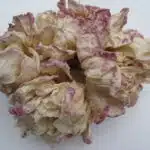Pruning roses is a task that is often viewed as daunting, but it is an essential aspect of maintaining healthy and beautiful plants. The process involves removing dead or damaged branches, shaping the plant to promote growth and bloom, and preventing disease. Proper pruning techniques can also improve air circulation and sunlight penetration, leading to stronger and more vibrant flowers.
As a horticulturalist with years of experience in gardening, I have witnessed firsthand the benefits of proper pruning techniques on roses. In this article, I will share my knowledge on how to prune roses effectively, providing step-by-step instructions for beginners and advanced gardeners alike. Whether you are looking to improve the health of your existing rose bushes or start a new garden bed, proper pruning will ensure that your plants thrive and provide you with stunning blooms for years to come.
Understanding The Benefits Of Pruning
As a horticulturalist or garden expert, pruning roses is an essential task that can enhance their blooming and prevent diseases. It is crucial to understand that pruning is not just about cutting off dead branches, but it’s also a way of maintaining the health and beauty of your roses. With proper pruning techniques, you can help your roses grow strong and healthy.
One of the benefits of pruning roses is enhanced blooming. When you prune your roses, you encourage them to produce more flowers by removing the weaker buds and branches. This allows the plant to focus its energy on developing stronger stems and larger flowers. Additionally, regular pruning helps to promote new growth, which can lead to more blooms throughout the season.
Another important benefit of pruning is disease prevention. By removing dead or diseased wood from your roses, you can prevent the spread of harmful bacteria or fungi that could infect other parts of the plant or other plants nearby. Properly pruned roses are less susceptible to pests and diseases, making them easier to maintain over time.
To begin with pruning your roses for optimal growth, we must first identify the right tools for this task.
Identifying The Right Tools For The Job
To properly prune roses, it’s important to have the right tools for the job. One of the most essential tools for pruning roses is a good pair of pruning shears. There are two main types of pruning shears: bypass and anvil.
Bypass pruners have a sharp blade that slices through branches, while anvil pruners have a flat blade that crushes branches against a cutting board. Bypass pruners are generally preferred for pruning roses because they make clean cuts that promote healing and growth. Anvil pruners can damage plants if not used correctly, but they may be useful for removing dead wood or woody stems.
Once you’ve selected your pruning shears, it’s important to use proper techniques when pruning your roses. Start by removing any dead or diseased wood, cutting back to healthy tissue. Then, remove any crossing or rubbing branches to prevent damage and encourage airflow. Finally, prune back any long or leggy stems to promote bushy growth and abundant blooms. With the right tools and techniques, you can keep your rose bushes healthy and beautiful year after year.
Now that you know about the different types of pruning shears and how to use them effectively, it’s time to consider when to prune your roses. Timing is crucial when pruning roses because it can affect their growth patterns and blooming times. In the next section, we’ll discuss the best times of year to prune various types of roses so you can achieve optimal results in your garden.
Choosing The Right Time To Prune
After identifying the right tools for the job, you may think that pruning roses is a piece of cake. Unfortunately, it’s not as easy as it seems. Some gardeners make common mistakes that lead to unhealthy plants and unsatisfactory blooms. To avoid such disasters, it’s crucial to follow best practices when pruning your roses.
Firstly, make sure you use clean and sharp tools to prevent disease transmission and damage to the plant tissue. You can sterilize your tools by wiping them with rubbing alcohol or a bleach solution before and after each use. Also, always cut at a 45-degree angle above an outward-facing bud to promote healthy growth and prevent water from accumulating around the cut.
Another mistake gardeners frequently make is overpruning their roses. While it’s important to remove dead or diseased wood, overpruning can weaken the plant and reduce its ability to produce flowers. It’s recommended that you prune no more than one-third of the total plant size in a single season. By following these simple best practices, you can ensure healthy plants with vibrant blooms.
Now that you know how to prune your roses properly, it’s time to prepare your plants for pruning. This involves removing any debris around the plant base and clearing away any weeds or grass nearby. Make sure you also gently tie back any remaining canes so that they don’t get in your way while pruning. With these preparations done, you’re now ready for the actual pruning process itself!
Preparing Your Plants For Pruning
To prepare your plants for pruning, you must have the necessary tools. The most important tool is a pair of sharp and clean pruners. This will ensure that the cuts made on the plant are precise and clean, which helps prevent the spread of disease. Other tools that may be necessary include loppers for thicker branches, pruning saws for larger branches, and gloves to protect your hands.
Once you have the necessary tools, it’s time to learn about proper pruning techniques. The first step is to identify the branches that need to be removed. Look for any dead or damaged branches, as well as any crossing or rubbing branches. Then, make a cut just above the bud facing outward from the center of the plant. This will encourage new growth in that direction.
It’s important to note that not all plants require heavy pruning every year. Some plants only need light pruning to remove dead or damaged branches. However, if you do need to prune heavily, it’s best to do so in late winter or early spring before new growth appears. This will give the plant enough time to recover before its growing season begins. With these tips in mind, you’ll be well on your way to preparing your plants for successful pruning and maintaining their health and beauty over time.
As you begin removing dead or damaged branches from your roses, keep in mind that this step is crucial for their overall health and vitality. Dead or diseased branches can eventually spread throughout the entire plant if left unchecked, leading to stunted growth and even death of the rose bush. Therefore, when removing these types of branches, make sure to cut them back until you reach healthy wood with no signs of decay or discoloration. By doing so, you’ll help promote new growth and ensure that your roses continue to thrive year after year without any issues arising from neglecting this important step in their care regimen.
Removing Dead Or Damaged Branches
In preparing your plants for pruning, it is important to understand the importance of identifying diseased branches. The presence of diseases in roses can lead to a reduced yield, and ultimately, a weaker plant. Contrary to popular belief, not all dead or damaged branches should be removed from the plant. In fact, some can be beneficial to the overall health of the plant.
When it comes to removing broken stems, it is important to do so carefully and with precision. This is because improperly cut stems can cause further damage to the plant or even introduce new diseases. Before making any cuts, gardeners should ensure that their tools are sharp and clean. They should also make sure that they are cutting at an appropriate angle and avoiding any unnecessary damage.
Cutting back overgrown stems is another important aspect of pruning roses. Overgrown stems can weaken the overall structure of the plant and reduce airflow to its leaves, which can lead to fungal infections. To prevent this from happening, gardeners should make careful cuts as close as possible to healthy buds when removing excess growth. By doing so, they will promote new growth while maintaining a strong and healthy plant structure.
Cutting Back Overgrown Stems
When it comes to cutting back overgrown stems on rose bushes, there are a few important trimming techniques to keep in mind. The first step is to identify which stems need to be pruned. Look for thick or woody stems that are crowding the plant and preventing new growth from forming. These can be cut back to just above a healthy bud or lateral shoot.
Once you have identified the stems that need to be pruned, it’s time to gather your tools and get started. Use sharp, clean pruning shears or loppers to make clean cuts that will heal quickly and prevent disease from entering the plant. Make each cut at a 45-degree angle just above a bud, and be sure not to leave behind any stubs or damage the surrounding bark.
As you work, keep in mind these pruning tips to help promote healthy growth in your rose bushes:
- Remove any damaged or diseased wood
- Cut back any crossing branches that may rub against each other
- Aim for an open center in your bush by removing any inward-facing branches
By following these guidelines, you’ll be able to effectively cut back overgrown stems on your rose bushes and encourage new growth. Next up: shaping your rose bushes for maximum beauty and health.
Shaping Your Rose Bushes
Pruning rose bushes is an important task for cultivating healthy and vibrant blooms. The basics of pruning include selecting the proper tools and timing the pruning correctly. Proper cutting techniques involve making clean cuts at the correct angles and avoiding contact with thorns. Additionally, it is important to consider the plant’s natural shape and structure when pruning for optimal results.
Pruning Basics
Pruning roses can be a daunting task, but with the right techniques and knowledge, it can also be a gratifying experience. Pruning is essential to maintain the health and beauty of your rose bushes. One of the most crucial pruning techniques is to remove dead, diseased or damaged canes. This will not only promote new growth but also prevent the spread of diseases throughout the plant.
Another important aspect of pruning is shaping your rose bushes to encourage better flowering and growth. Remove any crossing canes or those that are growing towards the center of the bush. Doing so allows for better air circulation and sunlight penetration, which helps reduce pest infestations and diseases. A common mistake when pruning roses is cutting them too short. It’s best to only trim up to one-third of the length, as cutting more than that may stunt their growth.
Overall, pruning basics involve knowing when and how to trim your rose bushes properly. Do this during their dormant stage in late winter or early spring before new growth appears. Always use clean, sharp tools such as pruners or loppers to make clean cuts at a 45-degree angle above an outward-facing bud eye. Remember that regular pruning promotes healthy growth and encourages beautiful blooms throughout the season while avoiding common mistakes ensures longevity for your plants for years to come!
Cutting Techniques
Shaping your rose bushes is vital to encourage better flowering and growth. This process involves cutting techniques that require skill and precision. One essential aspect of cutting techniques is the angle at which you cut the canes. The ideal cutting angle should be at a 45-degree angle above an outward-facing bud eye. This angle promotes new growth while ensuring that water does not collect on the cut surface, which could lead to diseases.
Another key consideration for cutting techniques is blade sharpening. Dull blades can damage the plant and cause jagged cuts that could leave openings for pests and diseases to enter. It’s best to sharpen your pruning tools before each use or at least once a year if you use them frequently. A sharp blade ensures clean, even cuts that promote healthy growth, while avoiding damaging or tearing off parts of the plant unnecessarily.
In summary, shaping your rose bushes requires precise cutting techniques such as cutting angles and blade sharpening. These techniques ensure that you make clean cuts that promote healthy growth while preventing pest infestations and disease spread throughout the plants. By incorporating these skills into your pruning routine during their dormant stage in late winter or early spring, you’ll be able to maintain healthy and beautiful roses throughout the season!
Promoting Healthy Growth
After shaping your rose bushes, it is important to maintain their health and promote proper growth through pruning techniques. Pruning is an essential practice that helps roses achieve their full potential in terms of size, shape, and bloom production. However, it is crucial to understand the different pruning techniques for each type of rose to avoid damaging the plant.
Pruning frequency varies depending on the type of rose, but a general rule of thumb is to prune once a year during early spring before new growth appears. This timing ensures that the rose will have enough time to recover from pruning before blooming. Deadheading or removing spent blooms throughout the growing season can also encourage more blooms and prevent disease.
When pruning roses, always use sharp and clean tools to prevent damage and infection. The three main types of pruning are rejuvenation pruning, maintenance pruning, and selective thinning. Rejuvenation pruning involves cutting back old wood at the base of the plant to stimulate new growth. Maintenance pruning focuses on removing dead or damaged branches and shaping the plant to a desired form. Selective thinning involves removing some branches entirely or cutting them back partially.
By following proper pruning techniques with appropriate frequency, you can enjoy healthy and beautiful roses in your garden for years to come. However, even with good practices in place, roses may still encounter disease and pests which can affect their growth and overall health. In the next section, we will discuss how to deal with these issues effectively without compromising their beauty.
Dealing With Disease And Pests
Preventing infestations and controlling fungal infections are essential in maintaining healthy roses. One effective way to prevent infestations is by keeping a clean garden. Remove any fallen leaves, stems, or debris that may harbor pests or fungal spores. Regularly inspect your roses for signs of pests such as aphids, spider mites, and thrips. If detected early, these pests can be easily controlled by spraying them with insecticidal soap or neem oil.
Fungal infections can be caused by many factors such as inadequate air circulation, poor drainage, or excess moisture. To avoid these conditions, plant roses in well-draining soil with plenty of sunlight and space between plants. Avoid overhead watering and water at the base of the plant instead. Consider using mulch to keep the soil moist while preventing water from splashing onto the leaves. If symptoms of fungal infection appear on your roses such as black spots or powdery mildew, treat them immediately with a fungicide spray.
Regular maintenance and care not only keep your roses beautiful but also promote their health and longevity. These simple steps can help prevent pest infestations and fungal infections so that your roses thrive in a clean environment. By taking proper care of your roses, you ensure that they grow strong enough to resist diseases and withstand harsh weather conditions.
Transition: Now that we have covered how to prevent disease and pest infestations on your rose plants let’s delve into pruning climbing roses to maintain their shape and promote new growth.
Pruning Climbing Roses
Dealing with disease and pests is an important aspect of rose care, but it is not the only consideration. Another critical component to successfully growing roses is proper pruning. While some roses require little pruning, others, such as climbing roses, require training and support to thrive.
One common method for training climbing roses is to tie their canes to a trellis or other support structure. This encourages the rose to grow upwards rather than sprawling on the ground. As the rose grows taller, additional ties may need to be added to keep it securely attached to the support structure. It is also important to periodically remove any dead or damaged canes from the plant.
Supporting climbing roses can be a bit more labor-intensive than supporting other types of plants, but the results are well worth it. Climbing roses add vertical interest and color to gardens and landscapes, making them a popular choice among gardeners. By properly training and supporting these plants, you can ensure that they reach their full potential and provide years of beauty in your garden. In the next section, we will discuss how to prune hybrid tea roses for optimal growth and health.
Pruning Hybrid Tea Roses
Pruning Hybrid Tea Roses is an important part of rose care, as it helps to control the size and shape of the plant, as well as encouraging new blooms. Timing is important when pruning, with late winter or early spring being the best time for most rose varieties. Pruning techniques can range from simple deadheading to more complex methods such as removing old wood and thinning out the interior of the bush. When pruning roses, it is important to have the right tools, such as a sharp, clean pair of pruners, loppers and saws. Using the right tools can help ensure that the rose bush is properly pruned and taken care of. Proper pruning of Hybrid Tea Roses can help create beautiful and healthy plants.
Timing Of Pruning
Timing is everything when it comes to pruning hybrid tea roses. The best practices for pruning these beautiful plants varies depending on where you live and the climate of your region. Generally, the ideal time to prune is in late winter or early spring, before new growth emerges.
One common mistake gardeners make is pruning too early in the fall, which can lead to new growth that will not survive the winter. Waiting too long to prune can also be detrimental, as it may promote disease and insect infestation. It’s important to wait until after the last hard freeze before beginning your pruning routine.
In summary, timing is crucial when it comes to pruning hybrid tea roses. Best practices involve waiting until late winter or early spring for optimal results. Common mistakes include pruning too early in the fall or waiting too long into the season, both of which can have negative effects on plant health and growth. By following these guidelines, you can ensure healthy and beautiful roses year after year.
Pruning Techniques
Pruning hybrid tea roses is an essential task that ensures the health and beauty of your plants. Knowing when to prune is critical, but equally important are the techniques used during pruning. Pruning frequency and depth can have a significant impact on the plant’s growth, flowering, and overall health.
Pruning frequency depends on the specific needs of each rose variety. In general, hybrid tea roses should be pruned annually to remove dead or diseased wood and maintain their shape. However, some varieties may require more frequent pruning to promote vigorous growth and improve flowering. It’s crucial to observe your roses carefully throughout the growing season and adjust your pruning routine accordingly.
Pruning depth refers to how much of the plant is removed during each pruning session. When pruning hybrid tea roses, it’s crucial to make clean cuts at a 45-degree angle just above a healthy bud eye. The ideal pruning depth varies depending on the age and size of the rose bush. Younger bushes require more moderate pruning, while older plants can tolerate more drastic cuts. By mastering these techniques, you can ensure healthy, vibrant roses year after year.
Tools Needed
Pruning hybrid tea roses is a task that requires not only knowledge and skill but also the right tools. Choosing pruning shears appropriate for the job is crucial in achieving clean cuts that promote healthy growth. It’s best to invest in high-quality pruning shears that can withstand frequent use and are comfortable to handle. Consider factors such as blade sharpness, durability, and ease of maintenance when selecting pruning shears.
Aside from selecting the right pruning tools, keeping them clean and well-maintained is equally important. Dirty or rusted tools can spread diseases among plants and damage their delicate tissues. Before each use, it’s essential to clean pruning tools with soapy water, rinse them thoroughly, and dry them completely. Applying a thin layer of oil after cleaning can help protect your tools against rust and corrosion.
In conclusion, choosing the right pruning shears and maintaining them regularly are essential steps in ensuring successful pruning of hybrid tea roses. Clean tools ensure that plants remain healthy by preventing the spread of disease while taking care not to cause any unnecessary harm during pruning. By investing in high-quality tools and taking care of them properly, you can enjoy beautiful blooms year after year.
Pruning Floribunda Roses
Pruning technique is an essential aspect of growing healthy and beautiful roses. Floribunda varieties, known for producing clusters of blooms, require specific pruning techniques to encourage optimal growth and flowering. Pruning Floribunda roses involves the removal of dead, diseased, or damaged wood to promote new growth and ensure the longevity of the plant.
The best time to prune Floribunda varieties is in late winter or early spring when the plant is still dormant. Start by removing any dead, diseased, or damaged wood using a pair of sharp pruning shears. Cut back any branches that cross over each other as they can cause damage and encourage disease. Leave behind 3-4 healthy canes that are spaced evenly around the plant’s center.
Floribunda roses require minimal pruning compared to other rose types. However, regular maintenance pruning throughout the growing season can help remove spent blooms and encourage new growth. Deadheading, or removing spent blooms promptly, promotes continuous blooming throughout the summer months. By following proper pruning techniques for your Floribunda rose variety, you can ensure healthy growth and abundant flowering year after year.
Transition: Now that you have learned about how to properly prune Floribunda roses let’s move on to another popular rose type – pruning shrub roses.
Pruning Shrub Roses
Pruning shrub roses can be a daunting task for many gardeners, but it is necessary to keep the plants healthy and blooming. Proper pruning techniques are crucial to maintain the shape of the plant and promote new growth. However, it is not uncommon for gardeners to make common mistakes that can harm the plant’s health.
One of the most common mistakes made while pruning shrub roses is cutting too much or too little. Over-pruning can lead to weak stems and fewer flowers, while under-pruning can result in an unshapely plant with deadwood. To avoid these mistakes, always use sharp and clean pruning tools, such as shears or loppers, to make precise cuts at a 45-degree angle.
Another mistake gardeners often make is pruning at the wrong time of year. It is recommended to prune shrub roses in late winter or early spring when they are dormant. Pruning during other times of the year may stimulate new growth that can be damaged by frost or other environmental factors. By following proper pruning techniques and avoiding common mistakes, your shrub rose will thrive and produce beautiful blooms year after year.
To ensure a successful pruning season, it’s important to maintain your pruning tools properly. After each use, wipe down blades with rubbing alcohol or bleach solution to prevent the spread of diseases between plants. Sharpen dull blades with a sharpening stone or file regularly to ensure clean cuts without tearing or crushing stems. Finally, store your tools in a dry place free from moisture and rust buildup. With well-maintained tools on hand, you’ll be ready for any pruning task that comes your way.
Maintaining Your Pruning Tools
Sharpening pruning tools is essential to ensure clean and precise cuts when pruning roses. A good quality file should be used to sharpen pruning blades, in order to maintain a sharp cutting edge. Cleaning pruning tools is necessary to prevent the spread of disease and preserve tool longevity. Disinfecting blades with rubbing alcohol or a dilute bleach solution is recommended after each use.
Sharpening Tools
Keeping your pruning tools sharp is key to maintaining healthy roses. Dull tools can damage the plant, making it more susceptible to disease and pests. Proper tool maintenance and sharpening technique are essential for effective pruning.
To maintain your tools, clean them after each use with a dry cloth or brush. This will remove any sap or debris that could cause rust or corrosion. Then, sharpen the blades with a sharpening stone or file, using proper technique to achieve a clean edge. It’s important to sharpen both sides of the blade evenly and at the same angle to ensure consistent cutting.
Using sharp pruning tools not only makes the job easier but also ensures that you are making clean cuts that promote healthy growth in your roses. Taking care of your tools by following proper maintenance techniques will extend their lifespan and keep them working effectively for years to come.
Cleaning Tools
Maintaining your pruning tools is an essential part of caring for your roses. It not only ensures that the job is done efficiently but also helps to promote healthy growth in your plants. In this article, we will discuss the importance of cleaning tools and maintaining sanitation while using them.
Cleaning techniques are crucial for keeping your pruning tools in good condition. After each use, it’s important to remove any dirt or debris that may have accumulated on the blades. This can be done with a dry cloth or brush. Additionally, if the blades have come into contact with any plant material that may carry diseases, it’s important to sanitize them before using them again.
Maintaining sanitation is also an essential part of caring for your pruning tools. This can be done by wiping down the tools with rubbing alcohol or a solution of one-part bleach to nine parts water after each use. This will help to kill any bacteria or viruses that may be present on the blades and prevent them from spreading to your plants. By following these cleaning techniques and maintaining sanitation, you can ensure that your pruning tools remain in good condition and continue to serve you well for years to come.
Troubleshooting Common Pruning Problems
Maintaining your pruning tools is essential in ensuring that you get the desired results when pruning roses. However, it is equally important to know how to prune roses properly to prevent regrowth and manage uneven growth.
To prevent regrowth, it is essential to cut at a 45-degree angle above an outward-facing bud. This method stimulates the bud to grow outwards rather than inwards towards the center of the plant resulting in a bushier and healthier looking rosebush. Additionally, remove any dead or diseased wood as this can cause regrowth or stunted growth. Properly pruned rose bushes will not only look better but also produce more blooms.
Managing uneven growth can be challenging, but there are several things you can do to ensure that your rose bushes grow evenly. First, make sure that you prune every stem back to a similar height. The goal is to encourage even growth throughout the plant so that no stem overshadows another. Also, consider using fertilizer with equal amounts of nitrogen, phosphorus, and potassium as these nutrients are essential for healthy growth.
In conclusion, proper pruning techniques are crucial for preventing regrowth and managing uneven growth in rose bushes. By cutting at a 45-degree angle above an outward-facing bud and removing dead or diseased wood, you can stimulate bushier and healthier-looking plants while also promoting blooming. Finally, remember that consistent care including regular pruning will help maintain your beautiful rose garden for years to come.
Conclusion
Pruning roses is a crucial task for maintaining the health and beauty of your garden. As a horticulturalist or garden expert, it is important to understand the benefits of pruning, such as promoting new growth and preventing disease. Choosing the right tools and timing for pruning are also key factors in ensuring success.
Before beginning the pruning process, inspect your plants for any dead or damaged branches that may need to be removed. Proper technique is essential when pruning floribunda and shrub roses, as each requires a different approach. It is also important to maintain your pruning tools regularly to ensure their longevity.
As with any gardening task, there may be common problems that arise during rose pruning. However, with proper knowledge and practice, these issues can be easily resolved. By following these guidelines and practicing proper techniques, you can ensure that your roses will thrive year after year.
Image Credits
- “Roses” by Patrick Ahles (featured)





























